by Hans Bennett
Hi folks,
this is my new article that just got released by the SF Bay View Newspaper, focusing on the campaign for a civil rights investigation for Mumia. It is a long article, but I thoroughly detail 5 key pieces of withheld evidence, and the article is broken into five sections accordingly. Please help spread the word about this campaign, and this article, which the SF Bay View Newspaper has granted permission for anyone to reprint, as long as the SFBV is cited as the original source.
Actions are being organized throughout the summer to support the campaign for a federal civil rights investigation, including at the upcoming NAACP convention in New York City, July 11-16. Organizers are focusing particularly on July 13, the day that Attorney General Holder will address the convention. Supporters will then be in Washington, D.C., on July 22 to lobby their elected officials and, in mid-September, they’ll return to Washington, D.C., for a major press conference. For more information on how you can support the campaign for a federal civil rights investigation, and to sign the online letter and petition to Attorney General Holder, please visit: http://freemumia.com/civilrights.html.
With this campaign, the movement supporting Mumia is fighting back after the US Supreme Court dealt such a terrible blow in April when it ruled to not consider Mumia's case for a new guilt phase trial. And, more outrageously, the court has YET to rule on the DA's appeal to execute Mumia without having a new sentencing hearing!
Let's fight back!
Hans Bennett
www.Abu-Jamal-News.com
---------------------------------------
http://www.sfbayview.com/2009/citing-withheld-evidence-supporters-of-mumia-abu-jamal-call-for-civil-rights-investigation/
June 16, 2009
by Hans Bennett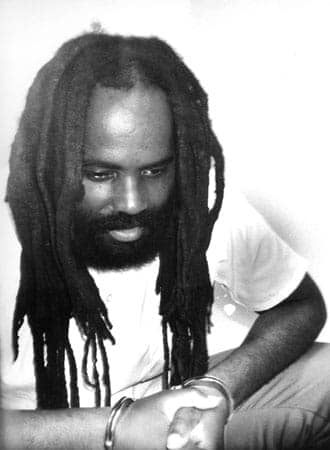
Despite a 2001 federal court decision overturning his death sentence, Mumia Abu-Jamal has never left his death row cell. – Photo: Prison Radio
On April 6, 2009, the U.S. Supreme Court refused to consider an appeal from death-row journalist and former Black Panther Mumia Abu-Jamal, who was convicted of first-degree murder in the shooting death of white Philadelphia Police Officer Daniel Faulkner in a 1982 trial deemed unfair by
Amnesty International, the European Parliament, the Japanese Diet, Nelson Mandela and numerous others. Citing the Supreme Court denial and several instances of withheld evidence, Abu-Jamal’s international support network is now calling for a federal civil rights investigation into Abu-Jamal’s case. The facts of the Abu-Jamal/Faulkner case are highly contested, but all sides agree on certain key points: Abu-Jamal was moonlighting as a taxi-driver on Dec. 9, 1981, when, shortly before 4 a.m., he saw his brother, William “Billy” Cook, in an altercation with Officer Faulkner after Faulkner had pulled over Cook’s car at the corner of 13th and Locust streets, downtown Philadelphia. Abu-Jamal approached the scene.
Minutes later when police arrived, Faulkner had been shot dead, and Abu-Jamal had been shot in the chest. The bullet removed from Faulkner, reportedly a .38, was officially too damaged to match it to the legally registered .38 caliber gun that Abu-Jamal says he carried as a taxi driver, after he was robbed several times on the job. Further, Amnesty International has criticized the official “failure of the police to test Abu-Jamal’s gun, hands, and clothing” for gunshot residue as “deeply troubling.”
Abu-Jamal has always maintained his innocence, and today still fights the conviction from his death-row cell in Waynesburg, Penn., where he also records weekly
radio commentaries and has now
written six books.
Recently, Abu-Jamal had petitioned the U.S. Supreme Court to review the U.S. Third Circuit Court ruling of March 27, 2008, which rejected his bid, based on three issues, for a new guilt-phase trial. One issue was that of racially discriminatory jury selection, based on the 1986 case Batson v. Kentucky, on which the three-judge panel split 2-1, with Judge Thomas Ambro dissenting.
Ambro argued that prosecutor Joseph McGill’s use of 10 out of his 15 peremptory strikes to remove otherwise acceptable African-American jurors was itself enough evidence of racial discrimination to grant Abu-Jamal a preliminary hearing that could have led to a new trial. In denying Abu-Jamal this preliminary hearing, Ambro argued that the court was creating new rules that were being exclusively applied to Abu-Jamal’s case. The denial “goes against the grain of our prior actions … I see no reason why we should not afford Abu-Jamal the courtesy of our precedents,” wrote Ambro.
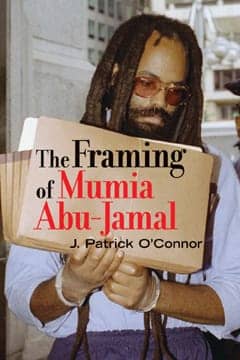
This is the cover of J. Patrick O’Connor’s book on Mumia’s case.
In his new essay titled “
The Mumia Exception,” author J. Patrick O’Connor argues that the Third Circuit Court’s rejection of the Batson claim and of the other two issues presented is only the latest example of the courts’ longstanding practice of altering existing precedent to deny Abu-Jamal legal relief. O’Connor cites many other problems, including the 2001 affidavit by a former court stenographer, who says that on the eve of Abu-Jamal’s trial, she overheard Judge Albert Sabo say to someone at the courthouse that he was going to “help” the prosecution “fry the nigger,” referring to Abu-Jamal. Common Pleas Judge Pamela Dembe rejected this affidavit on grounds that even if Sabo had made the comment, it was irrelevant as long as his “rulings were legally correct.” The phrase “Mumia exception” was first coined by
Linn Washington Jr., a Philadelphia Tribune columnist and professor of journalism at Temple University, who has covered this story since the day of Abu-Jamal’s 1981 arrest. Washington criticizes the Third Circuit’s ruling against Abu-Jamal’s claim that
Judge Sabo had treated him unfairly at the 1995-97 Post-Conviction Relief Act (PCRA) hearings, which was another issue the Circuit Court had considered. Citing “the mound of legal violations in this case,” Washington says “the continuing refusal of U.S. courts to equally apply the law in the Abu-Jamal case constitutes a stain on America’s image internationally.”
Launched campaign cites withheld evidence
The Philadelphia Inquirer has reported that supporters of Mumia Abu-Jamal are responding to the March 2009 U.S. Supreme Court ruling by
launching a campaign calling for a federal civil rights investigation into Abu-Jamal’s case. The campaign’s supporters include the Riverside Church’s Prison Ministry, actress Ruby Dee, professor Cornel West and U.S. Congressman Charles Rangel, who is chairman of the House Committee on Ways and Means.
In 2004, the NAACP passed a resolution supporting a new trial for Abu-Jamal, and campaign supporters will be gathering to publicize the civil rights campaign at the upcoming NAACP National Convention in New York City July 11-16 and to pressure the NAACP to honor their earlier resolutions by actively supporting the current campaign seeking an investigation. Supporters will then be in Washington, D.C., on July 22 to lobby their elected officials and, in mid-September, they’ll return to Washington, D.C., for a major press conference.
Thousands of signatures have been collected for a public letter to U.S. Attorney General Eric Holder, which reads: “Inasmuch as there is no other court to which Abu-Jamal can appeal for justice, we turn to you for remedy of a 27-year history of gross violations of U.S. constitutional law and international standards of justice.” The letter cites Holder’s recent investigation into the case of former Sen. Ted Stevens, which led to all charges against him being dropped: “You were specifically outraged by the fact that the prosecution withheld information critical to the defense’s argument for acquittal, a violation clearly committed by the prosecution in Abu-Jamal’s case. Mumia Abu-Jamal, though not a U.S. Senator of great wealth and power, is a Black man revered around the world for his courage, clarity and commitment and deserves no less than Senator Stevens.”
Supporters will be gathering to publicize the campaign for a federal civil rights investigation into Abu-Jamal’s case at the upcoming NAACP National Convention in New York City July 11-16.
Several campaigns seeking a civil rights investigation into the Abu-Jamal case have been launched since 1995, at which time the Congressional Black Caucus (CBC) was one of many groups that publicly supported an investigation. In a 1995 letter written independently of the CBC, Reps. Chaka Fattah, Ron Dellums, Cynthia McKinney, Maxine Waters and John Conyers - now chairman of the House Judiciary Committee - stated, “There is ample evidence that Mr. Abu-Jamal’s constitutional rights were violated, that he did not receive a fair trial, and that he is, in fact, innocent.”
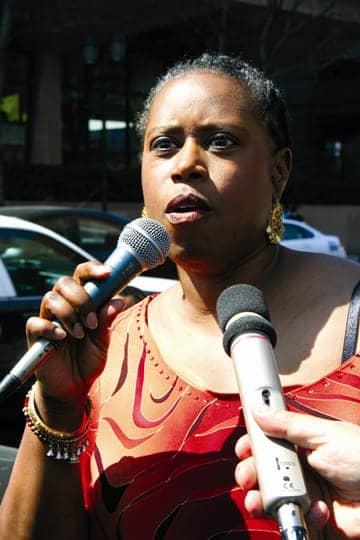
Among many political leaders around the world who speak out for justice for Mumia is former Congresswoman Cynthia McKinney, an avid supporter. Here she speaks at a Philadelphia rally for the world-renowned journalist on April 19, 2008. – Photo: Minister of Information JR
Assistant Attorney General Andrew Fois responded to the CBC’s request and, in a September 1995 rejection letter written to Congressman Ron Dellums, Fois conceded that even though there is a five-year statute of limitations for a civil rights investigation, the statute does not apply if “there is significant evidence of an ongoing conspiracy.” One of the 2009 campaign’s organizers is Dr. Suzanne Ross, a spokesperson for the
Free Mumia Abu-Jamal Coalition of New York City.
Citing Andrew Fois’ letter, Ross argues that the “continued denial of justice to Mumia in the federal courts, as documented by dissenting Judge Thomas Ambro,” is evidence of an “ongoing conspiracy” and thus merits an investigation. “Throughout the history of this case, we were always told ‘Wait until we get to the federal courts. They will surely overturn the racism and gross misconduct of Judge Sabo,’ but we never got even a preliminary hearing on the issue considered most winnable: racial bias in jury selection, the so called Batson issue.”
Ross also criticizes the Third Circuit’s denial of Abu-Jamal’s claim that Judge Sabo was unfair at the 1995-97 PCRA hearings and considers this denial to be further evidence of an “ongoing conspiracy.” Ross argues that the courts’ continued affirmation of Sabo’s rulings during the PCRA hearings and Sabo’s ultimate ruling that nothing presented at the PCRA hearings was significant enough to merit a new trial serves to legitimize numerous injustices throughout Abu-Jamal’s case.
Specifically referring to the issue of withheld evidence that was central to the case of former Sen. Ted Stevens, organizer Suzanne Ross identifies five key instances in Abu-Jamal’s case where “evidence was withheld that could have led to Mumia’s acquittal.” The DA’s office withheld two items from Abu-Jamal’s defense: the actual location of the driver’s license application found in Officer Faulkner’s pocket and Pedro Polakoff’s crime scene photos. Then, at the request of prosecutor McGill, Judge Sabo ruled to block three items from the jury: prosecution eyewitness Robert Chobert’s probation status and criminal history; testimony from defense eyewitness Veronica Jones about police attempts to solicit false testimony; and testimony from Police Officer Gary Waskshul.
DA suppresses evidence about Kenneth Freeman
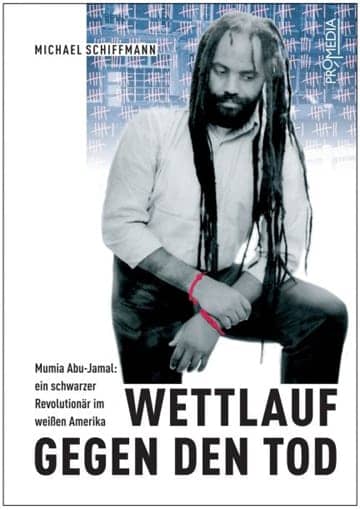
The title of Michael Schiffmann’s book, written in German, translates to “Race Against Death: Mumia Abu-Jamal, a Black Revolutionary in White America.” This is the cover.
In their recent books, Michael Schiffmann (”
Race Against Death: The Struggle for the Life and Freedom of Mumia Abu-Jamal,” 2006), and J. Patrick O’Connor (”
The Framing of Mumia Abu-Jamal,” 2008) argue that the actual shooter of Officer Faulkner was a man named Kenneth Freeman. Schiffmann and O’Connor argue that Freeman was an occupant of Billy Cook’s car who shot Faulkner in response to Faulkner having shot Abu-Jamal first, and then fled the scene before police arrived. Central to Schiffmann and O’Connor’s argument was the presence of a driver’s license application for one Arnold Howard, which was found in the front pocket of Officer Faulkner’s shirt. Abu-Jamal’s defense would not learn about this until 13 years later, because the police and DA’s office had failed to notify them about the application’s crucial location. Journalist Linn Washington argues that this failure was “a critical and deliberate omission” and “a major violation of fair trial rights and procedures. If the appeals process had any semblance of fairness, this misconduct alone should have won a new trial for Abu-Jamal.”
More importantly, Washington says, “This evidence provides strong proof of a third person at the scene along with Faulkner and Billy Cook. The prosecution case against Abu-Jamal rests on the assertion that Faulkner encountered a lone Cook minutes before Abu-Jamal’s arrival on the scene, but Faulkner got that application from somebody other than Cook, who had his own license.”
At the 1995 PCRA hearing, Arnold Howard testified that he had loaned his temporary, non-photo license to Kenneth Freeman, who was Billy Cook’s business partner and close friend. Further, Howard stated that police came to his house early in the morning on Dec. 9, 1981, and brought him to the police station for questioning because he was suspected of being “the person who had run away” from the scene, but he was released after producing a 4 a.m. receipt from a drugstore across town - which provided an alibi - and telling them that he had loaned the application to Freeman, who Howard reports was also at the police station that morning.
Also pointing to Freeman’s presence in the car with Cook, O’Connor and Schiffmann cite prosecution witness Cynthia White’s testimony at Cook’s separate trial for charges of assaulting Faulkner, where White describes both a “driver” and a “passenger” in Cook’s VW. Also notable, investigative journalist Dave Lindorff’s book (”
Killing Time: An Investigation into the Death Row Case of Mumia Abu-Jamal,” 2003) features an interview with Cook’s lawyer, Daniel Alva, in which Alva says that Cook had confided to him within days of the shooting that Freeman had been with him that morning.
Linn Washington argues that “this third person at the crime scene is consistent with eyewitness accounts of the shooter fleeing the scene. Remember that accounts from both prosecution and defense witnesses confirm the existence of a fleeing shooter. Abu-Jamal was arrested at the scene, critically wounded. He did not run away and return in a matter of seconds.” Eyewitnesses Robert Chobert, Dessie Hightower, Veronica Jones, Deborah Kordansky, William Singletary and Marcus Cannon all reported, at various times, that they saw one or more men run away from the scene.
O’Connor writes that “some of the eyewitnesses said this man had an Afro and wore a green army jacket. Freeman did have an Afro and he perpetually wore a green army jacket. Freeman was tall and burly, weighing about 225 pounds at the time.” Then there’s eyewitness Robert Harkins, whom prosecutor McGill did not call as a witness. O’Connor postulates that the prosecutor made that decision because Harkins’ account of a struggle between Faulkner and the shooter that caused Faulkner to fall on his hands and knees before Faulkner was shot “demolished the version of the shooting that the state’s other witnesses rendered at trial.” O’Connor writes further that “Harkins described the shooter as a little taller and heavier than the 6-foot, 200-pound Faulkner,” which excludes the 6-foot-1-inch, 170-pound Abu-Jamal.
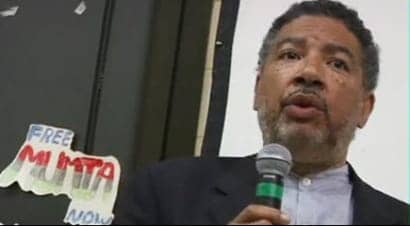
Journalism professor Linn Washington has covered Mumia’s fight for freedom from the beginning. Speaking at More Than a Book Party, the Philadelphia event April 24, 2009, celebrating the release of Mumia’s new book, “Jailhouse Lawyers,” he told the audience that Judge Albert Sabo, called the “hangman judge” even by the conservative Washington Times, has sentenced more defendants to death than any other judge in the U.S. – and that 75 percent of those death sentences have now been overturned. – Photo: Journalists for Mumia video
Linn Washington’s
2001 affidavit states that he knew Freeman to be a “close friend of Cook’s” and that “Cook and Freeman were constantly together.” Washington first met Freeman when Freeman reported his experience of police brutality to the Philadelphia Tribune, where Washington worked. Washington says today that “Kenny did not harbor any illusions about police being unquestioned heroes due to his experiences with being beaten a few times by police and police incessantly harassing him for his street vending.” Regarding the police harassment and intimidation of Freeman, which continued after the arrest of Abu-Jamal, Washington adds: “It is significant to note that the night after the Faulkner shooting, the newsstand that Freeman built and operated at 16th and Chestnut Streets in Center City burned to the ground. In news media accounts of this arson, police sources openly boasted to reporters that the arsonist was probably a police officer. Witnesses claimed to see officers fleeing the scene right before the fire was noticed. Needless to say, that arson resulted in no arrests.”
Dave Lindorff argues that the police clearly “had their eye on Freeman,” because “only two months after Faulkner’s shooting, Freeman was arrested in his home, where he was found hiding in his attic armed with a .22 caliber pistol, explosives and a supply of ammunition. At that time, he was not charged with anything.” O’Connor and Schiffmann argue that police intimidation ultimately escalated to the point where police themselves murdered Freeman.
The morning of May 14, 1985, Freeman’s body was found: naked, bound and with a drug needle in his arm. His cause of death was officially declared a “heart attack.” The date of Freeman’s death is significant because the night before his body was found, the police had orchestrated a military-style siege on the MOVE organization’s West Philadelphia home. Police had fired over 10,000 rounds of ammunition in 90 minutes and used a State Police helicopter to drop a C-4 bomb - illegally supplied by the FBI - on MOVE’s roof, which started a fire that destroyed the entire city block. The MOVE Commission later documented that police had shot at MOVE family members when they tried to escape the fire: In all, six adults and five children were killed.
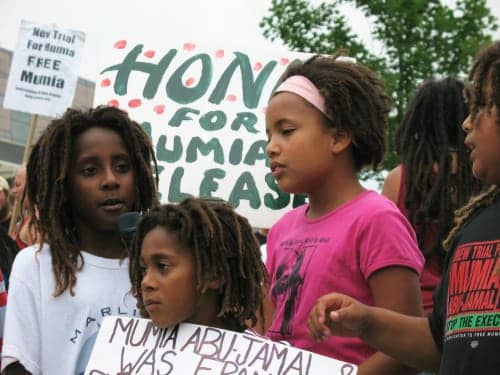
Mumia’s allegiance to MOVE is reciprocated by these MOVE children speaking out for his freedom at last year’s Liberty Bell rally in Philly on the Fourth of July. – Photo: Joe Piette, Workers World
As a local journalist, Abu-Jamal had criticized the city government’s conflicts with MOVE and, after his 1981 arrest, MOVE began to publicly support him. Through this mutual advocacy, which continues today, Abu-Jamal and MOVE’s contentious relationship with the Philadelphia authorities have always been closely linked. Seen in this context, Schiffmann argues that “if Freeman was indeed killed by cops, the killing probably was part of a general vendetta of the Philadelphia cops against their ‘enemies’ and the cops killed him because they knew or suspected he had something to do with the killing of Faulkner.” O’Connor concurs, arguing that “the timing and modus operandi of the abduction and killing alone suggest an extreme act of police vengeance.”
DA suppresses Pedro Polakoff’s crime scene photos
On Dec. 6, 2008,
several hundred protesters gathered outside the Philadelphia District Attorney’s office, where Pam Africa, coordinator of the International Concerned Family and Friends of Mumia Abu-Jamal, spoke about the newly discovered crime scene photos taken by press photographer Pedro Polakoff. Africa cited Polakoff’s statements today that he approached the DA’s office with the photos in 1981, 1982 and 1995 but that the DA had completely ignored him.
Polakoff states that because he had believed Abu-Jamal was guilty, he had no interest in approaching the defense, and never did. Consequently, neither the 1982 jury nor the defense ever saw Polakoff’s photos. “The DA deliberately kept evidence out,” declared Africa. “Someone should be arrested for withholding evidence in a murder trial.”
Advocacy groups called Educators for Mumia and Journalists for Mumia explain in their
fact sheet, “21 FAQs,” that Polakoff’s photos were first discovered by German author Michael Schiffmann in May 2006 and published that fall in his book, “
Race Against Death.” One of Polakoff’s photos was first published in the U.S. by the
San Francisco Bay View newspaper on Oct. 24, 2007.
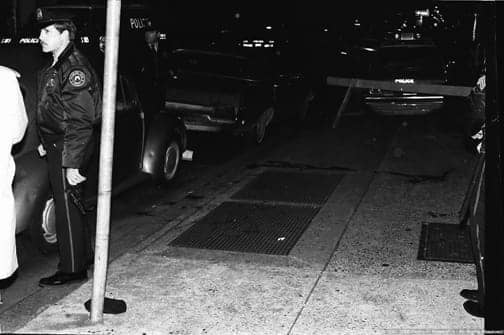
In this photo taken by freelance photographer Pedro Polakoff immediately after Officer Daniel Faulkner and Mumia Abu-Jamal were shot but suppressed by the DA and never made public until May 2006, Officer James Forbes holds both Abu-Jamal’s and Faulkner’s guns in his bare hand, touching the metal parts. This contradicts his later court testimony that he had preserved the ballistics evidence by not touching the metal parts. This is the photo that had never been published in the U.S. until it appeared on the front page of the SF Bay View on Oct. 24, 2007. – Photo: © Pedro P. Polakoff III
Reuters followed with a Dec. 4, 2007, article, after which the photos made their television debut on
NBC’s Dec. 6, 2007 Today Show. They have since been spotlighted by
National Public Radio,
Indymedia.org,
Counterpunch,
The Philadelphia Weekly and the new British documentary “
In Prison My Whole Life,” which features an interview with Polakoff. Since May, 2007,
www.Abu-Jamal-News.com has displayed four of Polakoff’s photos, making the following points:
Photo 1: Mishandling the Guns - Officer James Forbes holds both Abu-Jamal’s and Faulkner’s guns in his bare hand and touches the metal parts. This contradicts his later court testimony that he had preserved the ballistics evidence by not touching the metal parts.
Photos 2 and 3: The Moving Hat - Faulkner’s hat is moved from the top of Billy Cook’s VW and placed on the sidewalk for the official police photo.
Photo 4: The Missing Taxi - Prosecution witness Robert Chobert testified that he was parked directly behind Faulkner’s car, but the space is empty in the photo.
The Missing Divots - In all of Polakoff’s photos of the sidewalk where Faulkner was found, there are no large bullet divots, or destroyed chunks of cement, which should be visible in the pavement if the prosecution scenario was accurate. According to that account, Abu-Jamal shot down at Faulkner - and allegedly missed several times - while Faulkner was on his back. Also, citing the
official police photo, Michael Schiffmann writes: “It is thus no question any more whether the scenario presented by the prosecution at Abu-Jamal’s trial is true, because it is physically impossible.”
Pedro P. Polakoff was a Philadelphia freelance photographer who reports having arrived at the crime scene about 12 minutes after the shooting was first reported on police radio and at least 10 minutes before the arrival of the Mobile Crime Detection Unit that handles crime scene forensics and photographs. In Schiffmann’s interview with him, Polakoff recounted that “all the officers present expressed the firm conviction that Abu-Jamal had been the passenger in Billy Cook’s VW and had fired and killed Faulkner by a single shot fired from the passenger seat of the car.” Polakoff bases this on police statements made to him directly and from his having overheard their conversations.
Polakoff states that this early police opinion was apparently the result of their interviews of three other witnesses who were still present at the crime scene: a parking lot attendant, a drug-addicted woman and another woman. None of those eyewitnesses, however, have appeared in any report presented to the courts by the police or the prosecution.
It is undisputed that Abu-Jamal approached from across the street and was not the passenger in Billy Cook’s car. Schiffmann argues that Polakoff’s personal account strengthens the argument that the actual shooter was Billy Cook’s passenger Kenneth Freeman, who, Schiffmann postulates, fled the scene before police arrived.
Robert Chobert’s legal status withheld from jury
At prosecutor Joseph McGill’s request, Judge Albert Sabo blocked Abu-Jamal’s defense from telling the 1982 jury that key prosecution eyewitness, taxi driver Robert Chobert, was on probation for throwing a molotov cocktail into a school yard, for pay. Sabo justified this by ruling that Chobert’s offense was not
crimen falsi, i.e., a crime of deception. Consequently, the jury never heard about this, nor that on the night of Abu-Jamal’s arrest, Chobert had been illegally driving on a suspended license (revoked for a DWI). This probation violation could have given him up to 30 years in prison, so he was extremely vulnerable to pressure from the police. Notably, at the later 1995 PCRA hearing, Chobert testified that his probation had never been revoked, even though he continued to drive his taxi illegally through 1995.
At the 1982 trial, Chobert testified that he was in his taxi, which he had parked directly behind Faulkner’s police car, and was writing in his log book when he heard the first gunshot and looked up. Chobert alleged that while he did not see a gun in Abu-Jamal’s hand, nor a muzzle flash, he did see Abu-Jamal standing over Faulkner, saw Abu-Jamal’s hand “jerk back” several times, and heard shots after each “jerk.” After the shooting, Chobert stated that he got out and approached the scene.
Damaging Chobert’s credibility, however, is evidence suggesting that Chobert may have lied about his location at the time of Faulkner’s death. As noted earlier, the newly discovered Polakoff crime scene photos show that the space where Chobert testified to being parked directly behind Officer Faulkner’s car was actually empty.
Yet even more evidence suggests he lied about his location. While prosecution eyewitness Cynthia White is the only witness to testify seeing Chobert’s taxi parked behind Faulkner’s police car, no official eyewitness reported seeing White at the scene. Furthermore, Chobert’s taxi is missing both from White’s first sketch of the crime scene given to police (Defense Exhibit D-12) and from a later one (Prosecution Exhibit C-35). In a 2001 affidavit, private investigator George Michael Newman says that in a 1995 interview, Chobert told Newman that Chobert was actually parked around the corner, on 13th Street, north of Locust Street, and did not even see the shooting.
Amnesty International documents that both Chobert and White “altered their descriptions of what they saw, in ways that supported the prosecution’s version of events.” Chobert first told police that the shooter simply “ran away,” but after he had identified Abu-Jamal at the scene, he said the shooter had run away 30 to 35 “steps” before he was caught. At trial, Chobert changed this distance to 10 “feet,” which was closer to the official police account that Abu-Jamal was found just a few feet away from Officer Faulkner.
Nevertheless, Chobert did stick to a few statements in his trial testimony that contradicted the prosecution’s scenario. For example, Chobert declared that he did not see the apparently unrelated Ford car that, according to official reports, was parked in front of Billy Cook’s VW. Chobert also claimed that the altercation happened behind Cook’s VW (it officially happened in front of Cook’s VW), that Chobert did not see Abu-Jamal get shot or see Officer Faulkner fire his gun, and that the shooter was “heavyset” - estimating 200-225 pounds. Abu-Jamal weighed 170 pounds.
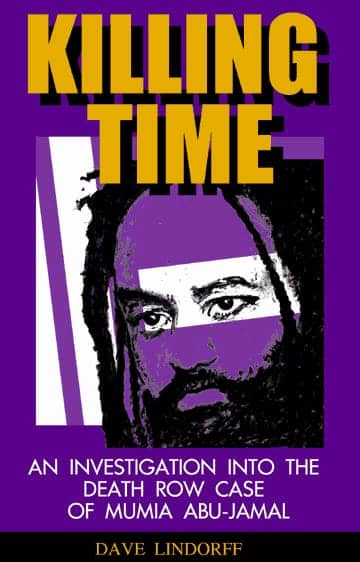
This is the cover of Dave Lindorff’s book on Mumia’s case.
In his 2003 book, “
Killing Time,” Dave Lindorff wrote about two other problems with Chobert’s account. While being so legally vulnerable, why would Chobert have parked directly behind a police car? Why would he have left his car and approached the scene if in fact the shooter were still there? Lindorff suggests that “at the time of the incident, Chobert might not have thought that the man slumped on the curb was the shooter,” because “in his initial Dec. 9 statement to police investigators, Chobert had said that he saw ‘another man’ who ‘ran away’ … He claimed in his statement that police stopped that man, but that he didn’t see him later.” Therefore, “if Chobert did think he saw the shooter run away, it might well explain why he would have felt safe walking up to the scene of the shooting as he said he did, before the arrival of police.”
The attempts to silence Veronica Jones
Veronica Jones was working as a prostitute at the crime scene on Dec. 9, 1981. She first told police on Dec. 15, 1981, that she had seen two men “jogging” away from the scene before police arrived. As a defense witness at the 1982 trial, Jones denied having made that statement; however, later in her testimony she started to describe a pre-trial visit from police: “They were getting on me telling me I was in the area and I seen Mumia, you know, do it. They were trying to get me to say something that the other girl [Cynthia White] said. I couldn’t do that.” Jones then explicitly testified that police had offered to let her and White “work the area if we tell them” what they wanted to hear regarding Abu-Jamal’s guilt.
At this point, prosecutor McGill interrupted Jones and moved to block her account, calling her testimony “absolutely irrelevant.” Judge Sabo agreed to block the line of questioning and strike the testimony and then ordered the jury to disregard Jones’ statement.
The DA and Sabo’s efforts to silence Jones continued through to the later PCRA hearings that started in 1995. Having been unable to locate Jones earlier, the defense found Jones in 1996, and, over the DA’s protests, obtained permission from the Pennsylvania Supreme Court to extend the PCRA hearings for Jones’ testimony. Sabo vehemently resisted - arguing that there was not sufficient proof of her unavailability in 1995. However, in 1995, Sabo had refused to order disclosure of Jones’ home address to the defense team.
Over Sabo’s objections, the defense returned to the state Supreme Court, which ordered Sabo to conduct a full evidentiary hearing. Sabo’s attempts to silence Jones continued as she took the stand. He immediately threatened her with five-10 years imprisonment if she testified to having perjured herself in 1982. In defiance, Jones persisted with her testimony that she had in fact lied in 1982, when she had denied her original account to police that she had seen two men “leave the scene.”
Jones testified that she had changed her version of events after being visited by two detectives in prison, where she was being held on charges of robbery and assault. Urging her to both finger Abu-Jamal as the shooter and to retract her statement about seeing two men “run away,” the detectives stressed that she faced up to 10 years in prison and the loss of her children if convicted. Jones testified in 1996 that in 1982, afraid of losing her children, she had decided to meet the police halfway: She did not actually finger Abu-Jamal, but she did lie about not seeing two men running from the scene. Accordingly, following the 1982 trial, Jones only received probation and was never imprisoned for the charges against her.
During the 1996 cross-examination, the DA announced that there was an outstanding arrest warrant for Jones on charges of writing a bad check and that she would be arrested after concluding her testimony. With tears pouring down her face, Jones declared: “This is not going to change my testimony!” Despite objections from the defense, Sabo allowed New Jersey police to handcuff and arrest Jones in the courtroom.
While the DA attempted to use this arrest to discredit Jones, her determination in the face of intimidation may, arguably, have made her testimony more credible. Outraged by Jones’ treatment, even the Philadelphia Daily News, certainly no fan of Abu-Jamal, reported: “Such heavy-handed tactics can only confirm suspicions that the court is incapable of giving Abu-Jamal a fair hearing. Sabo has long since abandoned any pretense of fairness.”
Jones’ account was given further credibility a year later. At the 1997 PCRA hearing, former prostitute Pamela Jenkins testified that police had tried pressuring her to falsely testify that she saw Abu-Jamal shoot Faulkner. In addition, Jenkins testified that in late 1981, Cynthia White - whom Jenkins knew as a fellow police informant - told Jenkins that she was also being pressured to testify against Abu-Jamal and that she was afraid for her life.
As part of a 1995 federal probe of Philadelphia police corruption, Officers Thomas F. Ryan and John D. Baird were convicted of paying Jenkins to falsely testify that she had bought drugs from a Temple University student. Jenkins’ 1995 testimony in this probe helped to convict Ryan, Baird and other officers and also to dismiss several dozen drug convictions. At the 1997 PCRA hearing, Jenkins testified that this same Thomas F. Ryan was one of the officers who attempted to have her lie about Abu-Jamal.
More recently, a
2002 affidavit by former prostitute Yvette Williams described police coercion of Cynthia White. The affidavit reads: “I was in jail with Cynthia White in December of 1981 after Police Officer Daniel Faulkner was shot and killed. Cynthia White told me the police were making her lie and say she saw Mr. Jamal shoot Officer Faulkner when she really did not see who did it … Whenever she talked about testifying against Mumia Abu-Jamal, and how the police were making her lie, she was nervous and very excited and I could tell how scared she was from the way she was talking and crying.”
Explaining why she is just now coming out with her affidavit, Williams says: “I feel like I’ve almost had a nervous breakdown over keeping quiet about this all these years. I didn’t say anything because I was afraid. I was afraid of the police. They’re dangerous.” Williams’ affidavit was rejected by
Philadelphia Judge Pamela Dembe in 2005, the
Pennsylvania Supreme Court in February 2008 and, in October 2008, by the
U.S. Supreme Court.
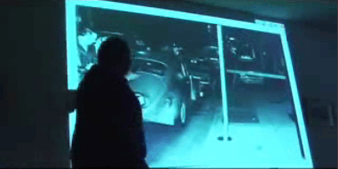
At a press conference in Philadelphia Dec. 4, 2007, Hans Bennett shows slides of the Pedro Polakoff crime scene photos. This one, known as “The Moving Hat,” shows Officer Faulkner’s hat on the top of Billy Cook’s VW. For the official police photo, it had been placed on the sidewalk. – Photo: Journalists for Mumia video
Further supporting the contention that police had made a deal with White, author J. Patrick O’Connor writes: “Prior to her becoming a prosecution witness in Abu-Jamal’s case, White had been arrested 38 times for prostitution … After she gave her third statement to the police, on December 17, 1981, she would not be arrested for prostitution in Philadelphia ever again even though she admitted at Billy Cook’s trial that she continued to be ‘actively working.’” Amnesty International reports that later, in 1987, White was facing charges of armed robbery, aggravated assault and possession of illegal weapons. A judge granted White the right to sign her own bail and she was released after a special request was made by Philadelphia Police Officer Douglas Culbreth - where Culbreth cited her involvement in Abu-Jamal’s trial. After White’s release, she skipped bail and has never, officially, been seen again.
At the 1997 PCRA hearing, the DA announced that Cynthia White was dead, and presented a death certificate for a “Cynthia Williams,” who died in New Jersey in 1992. However, Amnesty International reports, “an examination of the fingerprint records of White and Williams showed no match and the evidence that White is dead is far from conclusive.”
Journalist C. Clark Kissinger writes, a Philadelphia police detective “testified that the FBI had ‘authenticated’ that Williams had the same fingerprints as White.” However, Kissinger continues, “the DA’s office refused to produce the actual fingerprints,” and “the body of Williams was cremated so that no one could ever check the facts! Finally, the Ruth Ray listed on the death certificate as the mother of the deceased Cynthia Williams has given a sworn statement to the defense that she is not the mother of either Cynthia White or Cynthia Williams.” Dave Lindorff reports further that the listing of deaths by social security number for 1992 and later years does not include White’s number.
Gary Wakshul’s testimony blocked
On the final day of testimony during the original trial, Abu-Jamal’s lawyer discovered Police Officer Gary Wakshul’s official statement in the police report from the morning of Dec. 9, 1981. After riding with Abu-Jamal to the hospital and guarding him until treatment for his gunshot wound, Wakshul reported: “The negro male made no comment.” This statement contradicted the trial testimony of prosecution witnesses Gary Bell, a police officer, and Priscilla Durham, a hospital security guard, who testified that they had heard Abu-Jamal confess to the shooting while Abu-Jamal was awaiting treatment at the hospital.
When the defense immediately sought to call Wakshul as a witness, the DA reported that he was on vacation. Judge Sabo denied the defense request to locate him for testimony, on grounds that it was too late in the trial to even take a short recess so that the defense could attempt to locate Wakshul. Consequently, the jury never heard from Wakshul, nor about his contradictory written report. When an outraged Abu-Jamal protested, Judge Sabo replied: “You and your attorney goofed.”
Wakshul’s report from Dec. 9, 1981, is just one of the many reasons cited by Amnesty International for their conclusion that Bell’s and Durham’s trial testimonies were not credible. There are many other problems that merit a closer look if we are to determine how important Wakshul’s 1982 trial testimony could have been.
The alleged “hospital confession,” in which Abu-Jamal reportedly shouted, “I shot the motherf***er and I hope he dies,” was first officially reported to police over two months after the shooting, by hospital guards Priscilla Durham and James LeGrand on Feb. 9, 1982, by Police Officer Gary Wakshul on Feb. 11, by Officer Gary Bell on Feb. 25, and by Officer Thomas M. Bray on March 1. Of these five, only Bell and Durham were called as prosecution witnesses.
When Durham testified at the trial, she added something new to her story which she had not reported to the police on Feb. 9. She now claimed that she had reported the confession to her supervisor the next day, on Dec. 10, making a handwritten report. Neither her supervisor nor the alleged handwritten statement was ever presented in court. Instead, the DA sent an officer to the hospital, returning with a suspicious typed version of the alleged Dec. 10 report. Sabo accepted the unsigned and unauthenticated paper despite both Durham’s disavowal - because it was typed and not handwritten - and the defense’s protest that its authorship and authenticity were unproven.
Gary Bell, Faulkner’s partner and self-described “best friend,” testified that his two month memory lapse had resulted from his having been so upset over Faulkner’s death that he had forgotten to report it to police.
Later, at the 1995 PCRA hearings, Wakshul testified that both his contradictory report made on Dec. 9, 1981 - “The negro male made no comment” - and the two month delay were simply bad mistakes. He repeated his earlier statement given to police on Feb. 11, 1982, that he “didn’t realize it [Abu-Jamal's alleged confession] had any importance until that day.” Contradicting the DA’s assertion of Wakshul’s unavailability in 1982, Wakshul also testified in 1995 that he had in fact been home for his 1982 vacation and available for trial testimony, in accordance with explicit instructions to stay in town for the trial so that he could testify if called.
Just days before his PCRA testimony, undercover police officers savagely beat Wakshul in front of a sitting judge in the Common Pleas Courtroom where Wakshul worked as a court crier. The two attackers, Kenneth Fleming and Jean Langen, were later suspended without pay as punishment. With the motive still unexplained, Dave Lindorff and J. Patrick O’Connor speculate that the beating may have been used to intimidate Wakshul into maintaining his “confession” story at the PCRA hearings.
Regarding Abu-Jamal’s alleged confession, Amnesty International concluded: “The likelihood of two police officers and a security guard forgetting or neglecting to report the confession of a suspect in the killing of another police officer for more than two months strains credulity.”
Conclusion: The DA still wants to execute
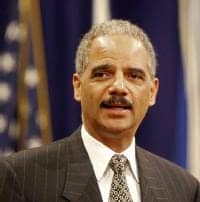
You can join the thousands of supporters around the world in calling on Attorney General Eric Holder to conduct a civil rights investigation into Mumia’s case by going to http://freemumia.com/civilrights.html and signing the petition. – Photo: AP
“The urgent need for a civil rights investigation is heightened because the DA is still trying to execute Mumia,” emphasizes Dr. Suzanne Ross, an organizer of the campaign seeking an investigation. This past March, the U.S. Supreme Court declined to hear Abu-Jamal’s appeal for a new guilt-phase trial, but the Court has yet to rule on whether to hear the appeal made simultaneously by the Philadelphia District Attorney’s office, which seeks to execute Abu-Jamal without granting him a new penalty-phase trial. In March 2008, the Third Circuit Court affirmed Federal District Court Judge William Yohn’s 2001 decision “overturning” the death sentence. Citing the 1988 Mills v. Maryland precedent, Yohn had ruled that sentencing forms used by jurors and Judge Albert Sabo’s instructions to the jury were potentially confusing, and that therefore jurors could have mistakenly believed that they had to unanimously agree on any mitigating circumstances in order to consider them as weighing against a death sentence.
According to the 2001 ruling, affirmed in 2008, if the DA wants to re-instate the death sentence, the DA must call for a new penalty-phase jury trial. In such a penalty hearing, new evidence of Abu-Jamal’s innocence could be presented, but the jury could only choose between execution and a life sentence without parole.
The DA is appealing to the U.S. Supreme Court against this 2008 affirmation of Yohn’s ruling. If the court rules in the DA’s favor, Abu-Jamal can be executed without benefit of a new sentencing hearing. If the U.S. Supreme Court rules against the DA’s appeal, the DA must either accept the life sentence for Abu-Jamal or call for the new sentencing hearing. Meanwhile, Mumia Abu-Jamal has never left his death row cell.
How you can help
Actions are being organized throughout the summer to support the campaign for a federal civil rights investigation, including at the upcoming NAACP convention in New York City, July 11-16. Organizers are focusing particularly on July 13, the day that Attorney General Holder will address the convention. Supporters will then be in Washington, D.C., on July 22 to lobby their elected officials and, in mid-September, they’ll return to Washington, D.C., for a major press conference.
For more information on how you can support the campaign for a federal civil rights investigation, and to sign the online letter and petition to Attorney General Holder, please visit: http://freemumia.com/civilrights.html.Hans Bennett is an independent multi-media journalist (www.insubordination.blogspot.com) and co-founder of Journalists for Mumia Abu-Jamal (www.Abu-Jamal-News.com). Born and raised in the San Francisco Bay Area, Bennett has been researching Abu-Jamal’s case for over 10 years and lived in Philadelphia for seven years, documenting the movement to free Mumia and all political prisoners from the frontlines of the struggle.














